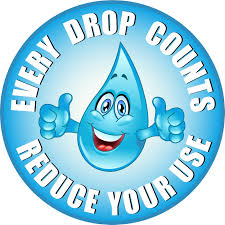
We’re nearing the end of the 2014/15 rainy season, but with another year of low rain, reservoirs remain low. Many creeks are still dry, and ponds in some public parks have been allowed to dry up. As one example of the drought’s severity, the visitor’s center at Hearst Castle has been forced to shut down its public restrooms and switch to portable outdoor waterless toilets. Most of us don’t recognize the seriousness of California’s 4th year of drought until we experience something like that.
With no relief this winter, we need a redoubled effort of near-term water conservation, but we actually did a little backsliding. December 2014 water use was down some 22% compared to the year before, yet January 2015 usage was only some 9% less than the previous January. It’s absolutely critical that everyone — residents, business owners, facilities managers, and agriculture — do their part.
In this post we’ll cover some of the things households and commercial interests should be doing. This includes tips for quick reductions as well as plumbing and appliance measures to address our long-term problem. Most will also save you some money.
Important Conservation Measures for Today
In Southern California we’ve already implemented many water-saving measures over the years, but we need to pay attention to our habits and make an extra effort for the next few years.
Mandated
Outdoor water use accounts for around 1/2 of residential consumption, and restrictions can be easily enforced. So there are several mandates concerning big water wastes, carrying fines on the order of $500 for violations. Depending on your location they typically include the following.
- Improperly adjusted sprinklers leading to run-off on to sidewalks or streets.
- Watering during the heat of the day.
- Using a hose to clean driveways or sidewalks.
- Washing a vehicle with a hose lacking a self-closing nozzle.
These measures save hundreds of gallons of water per month for each of millions of locations.
Also Important
There are many other ways we can save significant amounts of water in our homes and businesses.
- Fix leaks promptly. A single leak often wastes 20 gallons every day; that’s over 500 gallons a month.
- Use your dishwasher only for full loads.
- When washing dishes by hand, soak them rather than scrubbing under flowing water.
- Shower rather than taking a bath. Filling a bathtub just once can take over 50 gallons. Try to limit your showers to around 5 minutes; that’s less than 15 gallons.
- For those who can’t shower, lowering the water level in the tub a bit can save hundreds of gallons each month.
Sometimes making seeming minor changes can actually make a big difference. Something as simple as turning off the water while brushing your teeth can save the average family some 300 gallons of water a month. The same goes for turning off the water while washing your hair.
Outdoors, mulching can go a long way. Not only can it make your landscaping or garden healthier, it can safe some 25 gallons per watering for every 1,000 square feet of area (smaller than 30 by 35 feet). Watering heavily, but less often, also saves significantly overall.
For More Information and Water Conservation Tips
There are innumerable tips and tricks for saving water. Here are just two of the websites we’ve found helpful.
http://saveourwater.com/what-
Efficient Water Use for Tomorrow
Water shortages are a long-term problem for Californians, so we need to continue to improve the effectiveness of how we use water. Whenever it’s time for a major repair or remodeling, lean towards replacement with water-efficient fixtures and appliances. Many qualify for grants and rebates, for both residential and commercial properties. You can learn about them here: http://socalwatersmart.com/.
Here are some highlights.
Indoor Water Use
Even with modern fixtures, toilets together with clothes washers account for about 1/4 of all home water use. A new water-efficient washing machine can save some 15 gallons per load. The latest toilets use even less water, especially dual-flush models. For commercial buildings, waterless urinals are now effective — clean, odorless, and low maintenance. Even if you already have low-flow shower heads, the latest fixtures can provide a further 20% reduction in water consumption. A water efficient dishwasher can save roughly 5 gallons per load. Many of these steps qualify for rebates and other incentives.
Outdoor Water Use
Soil moisture meters can fine-tune your watering schedule so that you’re not wasting water by irrigating when it’s not needed. Installing a drip irrigation system avoids the surprisingly large water loss from evaporation from using sprinklers. Switching to drought-tolerant landscaping is the biggest win, saving 30 to 60 gallons per watering for every 1,000 square feet. The various rebates and grants also cover special sprinklers, rain barrels, soil moisture sensors, and even for reducing the square footage of turf.
Give ASAP Drain Guys & Plumbing a call if you’re interested in taking the next step, consulting with a professional about how you can do your part to conserve this precious commodity.

